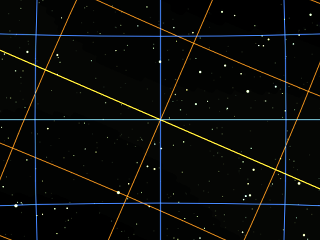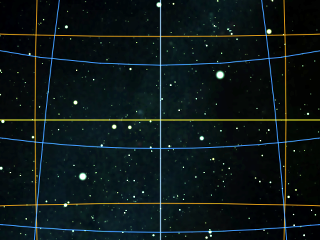As the solar time Wikipedia page illustrates, we can split a solar day into a constant 23h56m to complete a rotation relative to the stars (a sidereal day) and a variable ~4m to compensate for one day's angularorbital motion around the Sun. The Sun's apparent motion around the equator determines how much more than 360$^\circ$ the Earth must rotate from one solar noon to the next.
ConsiderBut the relationship between equatorial coordinates, aligned withEarth orbits the Earth's rotation, and ecliptic coordinates, aligned withSun in the Earth's orbit aroundecliptic plane, which is oblique to the Sunequator. If that orbit were circular, the Sun's ecliptic longitude would ecliptic longitude would change at a constant rate (see Note below). One degree aroundalong the equator spans exactly 4m00s of right ascension; right ascension; one degree aroundalong the ecliptic, measured around the equator, may span ~8% more or less than that.
At an equinox, the ecliptic crosses the equator at a 23.4$^\circ$ angle, and one degree of ecliptic longitude spans 3m40s of right ascension. The Sun appears to move slower than average around the equator, so the apparent solar day is slightly shorter.
At a solstice, the ecliptic is tangent to a $\pm$23.4$^\circ$ declination parallel, and one degree of ecliptic longitude spans 4m22s of right ascension. The Sun appears to move faster than average around the equator, so the apparent solar day is slightly longer.

 Stellarium images around the March equinox and the June solstice,
showing 30 degrees of ecliptic longitude and 2 hours of right ascension for comparison.
Equatorial grid is blue, ecliptic grid is orange, ecliptic is yellow.
Stellarium images around the March equinox and the June solstice,
showing 30 degrees of ecliptic longitude and 2 hours of right ascension for comparison.
Equatorial grid is blue, ecliptic grid is orange, ecliptic is yellow.
The equation of time is the cumulative sum of differences between mean and apparent solar day length. Like a mathematical function and its derivative, zero crossings of one should roughly correspond to maxima or minima of the other. Differences of a few seconds per day, several weeks in a row, add up to a few minutes.
The earliest/latest sunrise and latest/earliest sunset of the year do occur several days on either side of the summer/winter solstice. However, on any given day, sunrise, noon, and sunset are all behind or ahead of mean solar time by approximately the same amount within a few seconds.
Note: the Earth's orbit is not quite circular. Following Kepler's second law, the Sun's ecliptic longitude changes ~3% slower at aphelion and faster at perihelion, making the apparent solar day slightly shorter or longer respectively. This Wikipedia entry discusses it in more detail.